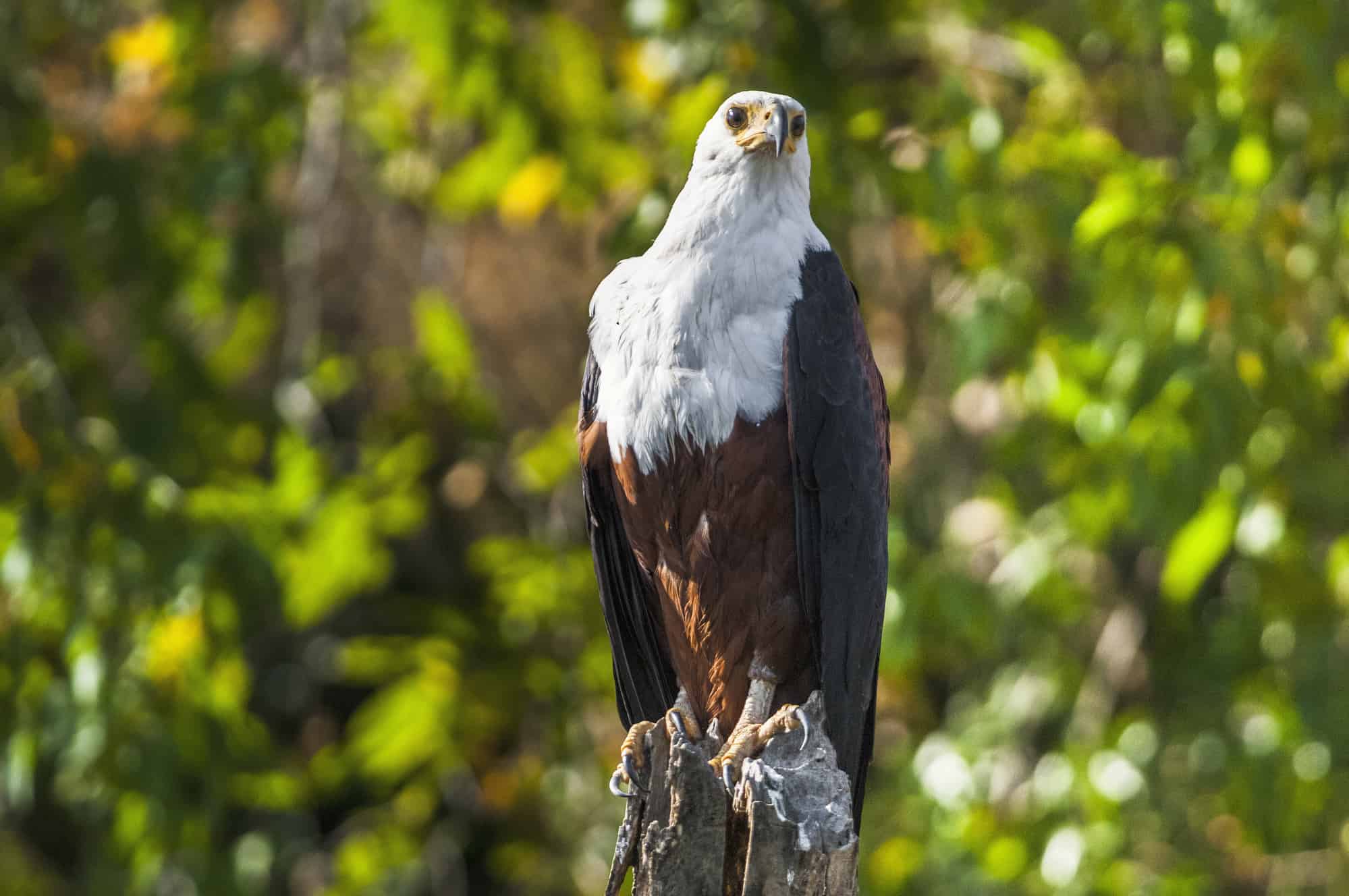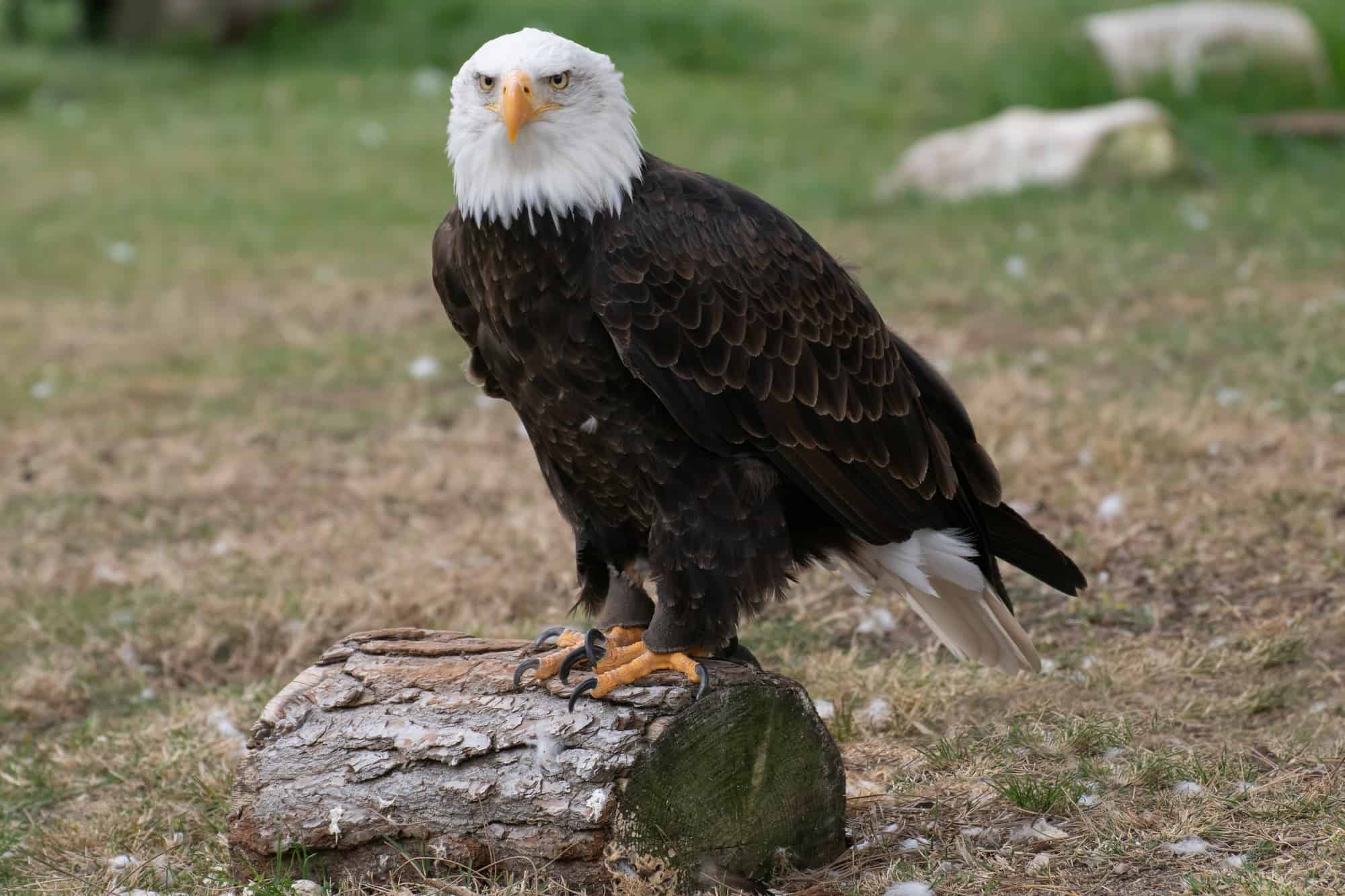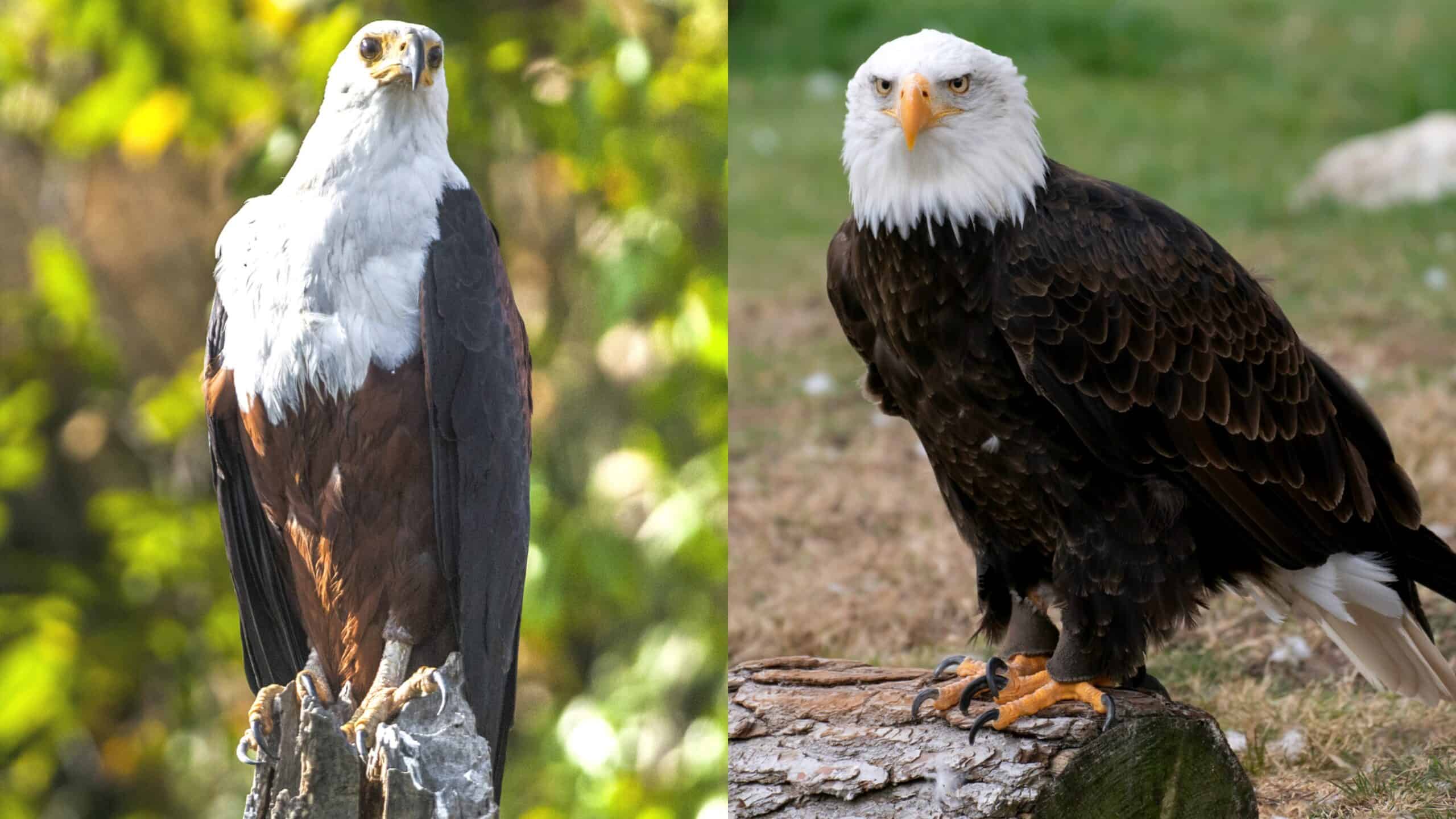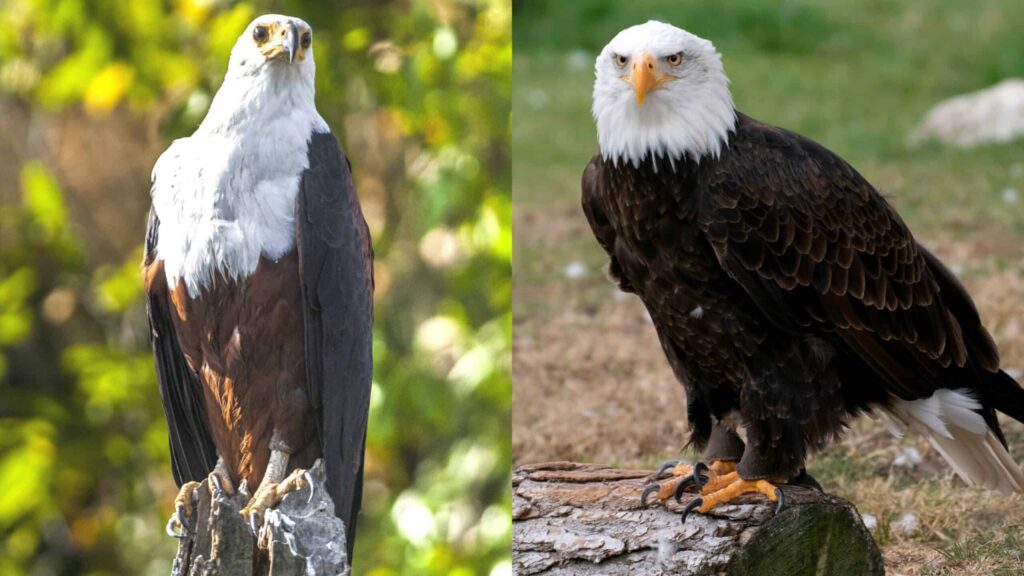The Bald Eagle is surely the most iconic bird in the US. For many, these birds inspire awe and wonder, especially as we have watched them come back from being endangered.
We tend to think of the Bald Eagle as an incredibly unique bird, but did you know there are some similar-looking birds around the world? For example, Red-Tailed Hawks and Turkey Vultures are sometimes mistaken for Bald Eagles in flight!
Juvenile Bald Eagles, who lack the distinctive white head of the adult bird, are often confused with other raptors. Once they become adults, Bald Eagles are pretty easy to recognize. So, if there is confusion, it’s usually because they are in flight and/or very far away.
However, there is one bird that looks strikingly similar to the Bald Eagle: The African Fish Eagle.
All About the African Fish Eagle

Let’s start by talking about the African Fish Eagle. Then, we’ll explore the similarities and differences between the Bald Eagle and the African Fish Eagle.
The wingspan of a male African Fish Eagle is about 6.6 feet, and the female’s wingspan is 7.9 feet. Their length is between 25-29.5 inches, and they weigh between 4.6-7.9 pounds.
These stats make them a large bird, but not as large as the Bald Eagle. They also aren’t the largest eagles in Africa- that honor goes to the stunning Martial Eagle.
The African Fish Eagle is mostly brown and has a white head. This is why they are so often compared to Bald Eagles: the similarities at a first glance are quite striking.
However, notice that the African Fish Eagle’s white coloring extends much farther down the chest than that of a Bald Eagle.
The bird’s face is yellow and featherless, and the black-tipped yellow beak is hooked like any other raptor. Its eyes are dark brown, and it has sharp, powerful talons.
Fun Facts About the African Fish Eagle
The African Fish Eagle is the national bird of Zambia, Zimbabwe, and South Sudan.
It has a loud, distinctive call, which you can hear in this video.
The Fish Eagle is very territorial, too. According to the Peregrine Fund, this bird “vigorously defends its home turf from other fish eagles or any other bird or critter it perceives as a threat.”
Additionally, it usually only spends time in pairs or small groups of related family members. Sometimes, fish eagles will flock together in groups that may number up to 75, but this is usually under extreme circumstances like a drought.
Is the African Fish Eagle a True Eagle?
Aquilas are the genus of true eagles. One of the distinctive factors of a “true eagle” is that it has feathers all the way down to its feet.
African Fish Eagles are members of the Haliaeetus genus, as are Bald Eagles. Notice that neither bird has feathers down to its feet. Instead, the feathers end just a couple of inches higher.
However, African Fish Eagles, Bald Eagles, and all eagles in the Aquilas genus are considered to be “typical eagles.” This means they are going to have “eagle” in their name and will generally be described as eagles by both laypeople and biologists.
The Fish Eagle’s Diet
The African Fish Eagle, like a sea eagle, eats a diet that mostly consists of fish. Their incredibly strong talons allow them to grip the slippery, wriggling fish that make up their diet, and the coarse skin of their feet gives them additional traction.
In addition to eating fish, they will sometimes eat waterfowl like ducks, storks, and ibis, as well as flamingos, baby crocodiles, and small turtles.
Bald Eagles and Fish Eagles have very similar diets. Bald Eagles will also eat turtles, small mammals, and lizards. These are both carnivorous birds of prey who are excellent hunters.
They can see their prey from a distance and will swoop down to catch it. Afterward, they will fly off with their prey and eat it somewhere else.
American Fish Eagles can carry up to 4 pounds, which means they can take on some pretty hefty prey. If they want to carry something even heavier, they can catch it and drag it across the surface of the water so that they don’t have to carry so much weight.
Bald Eagles are known for their habit of stealing prey from other birds of prey, such as ospreys.
The Most Feared Eagles
Sometimes, eagles may inspire fear in people.
After all, they are very large birds, and if you have seen one up close, you know what kind of damage they could do!
Just look at how people who are trained and credentialed to handle eagles of any kind will always wear protective gloves and gear. Those talons are not to be messed with!
Although Bald Eagles and African Fish Eagles are very large, the most powerful and the most intimidating eagle in the world is actually the Harpy Eagle.
Harpy Eagles are huge, coming in at 3 feet long. Even though the Golden Eagle and the Bald Eagle have larger wingspans than the Harpy Eagle, the Harpy has incredibly strong feet and legs.
To understand just how big a Harpy Eagle’s talons are, imagine a grizzly bear’s claws. The Harpy Eagle’s hind toe has a 3-4 inch talon, which is the same size as the claws of a grizzly.
African Fish Eagle vs. Bald Eagle Habitat

Bald Eagles are found exclusively in North America, and African Fish Eagles are found exclusively in Africa. There will never be a situation where these two birds are living in the same territory in the wild.
Bald Eagles breed across Canada, and they spend the winter in most of the US. They are year-round residents of the northern Pacific Coast, the Atlantic Coast, and the Gulf Coast.
Their preferred habitat is a lake or reservoir that is surrounded by woodlands, which gives them plenty of places to perch and nest, not to mention lots of food.
African Fish Eagles are found throughout southern Africa, especially in the Rift Valley Lakes. They, too, need access to lakes with plenty of fish.
African Fish Eagle vs. Bald Eagle Breeding Practices
Bald Eagles and African Fish Eagles are generally monogamous. Well, that is to say, Bald Eagles are definitely monogamous, as they pair with a mate for their entire life. African Fish Eagles are probably monogamous, but there is less concrete evidence of that fact.
Bald Eagles bond through a series of aerial performances. Once they pair together, they collaborate on building a massive nest. These nests are located in either a tree or along a rocky cliff, which are made out of sticks and branches.
African Fish Eagles breed during the dry season. Bonded mates work together on a nest, also made of sticks and wood. They will usually re-use the same nest year after year. Their nests are up to 6 feet across and 4 feet deep!
Nesting and Reproduction
The African Fish Eagle lays between one and three eggs. They are mostly white, but they are speckled in red, and females incubate the eggs for 42-45 days. When they need to leave the nest to hunt, the male takes over and incubates for her.
Bald Eagles also lay between one and three eggs, which incubate for 33.5 days. If a Bald Eagle nest is destroyed while the eggs are incubating, the female might lay a second clutch.
Bald Eagle and Fish Eagles: Indicator Species

Both Bald Eagles and African Fish Eagles are indicator species.
An indicator species is a denomination that is an indicator of the general health and well-being of a natural environment or ecosystem.
Basically, if an indicator species is doing well, that means that they have everything they need from their environment to survive and thrive. If they are starving, sick, or struggling, then there are concerns regarding the health of the ecosystem.
Both Bald Eagles and African Fish Eagles serve this role. Biologists can study their health, reproduction, and overall success in order to determine if there are any problems that haven’t yet been noticed through research.
How to See an African Fish Eagle in Person
Although African Fish Eagles are only found in Africa in the wild, they can be seen in some zoos around the world.
If you can travel to one of these zoos, you can see an African Fish Eagle for yourself, even if you aren’t able to see one in southern Africa.
African Fish Eagles are fascinating birds and definitely worth learning more about. Having the opportunity to see one in person would certainly be educational!

